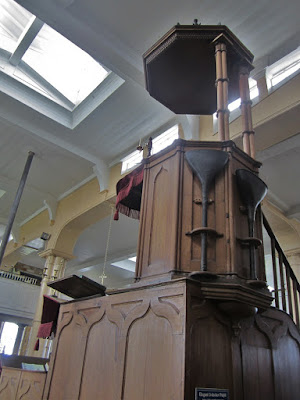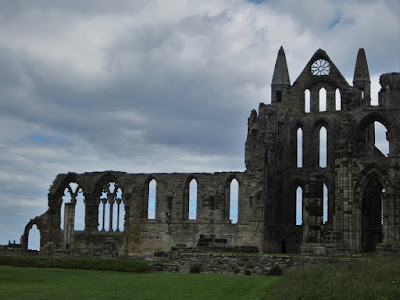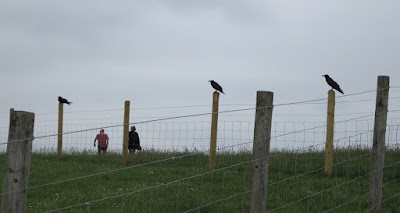My father announced some years ago now that he would like to visit Lulworth Cove and Durdle Door in Dorset, a desire he's often repeated since. I've lost count of the number of times I've offered to drive him there but he's always had a reason not to go - too cold, too wet, too hot, too pretty much anything really. To which he'd add, 'There's plenty of time'.
I began to think that I would never get him there, and that when I did eventually visit myself, maybe after his death, I would be consumed with guilt at my failure, even though I'd know I'd tried my hardest. Three years ago, I even wrote a poem about not taking him to Lulworth Cove.
When my sister announced that she and her husband would be taking the parents on holiday to Dorset, I heaved a sigh of relief. Far easier to herd them there from a distance of six miles. And I could go down too, and spend the day with them.
So as soon as I'd cast my vote in the EU referendum, I set off. It was a good day for a jaunt, beautiful in a grey sort of way, as this country so often is. And despite worries about which way the vote would go, I was glad I was finally going to cross Lulworth Cove off the List of Places To Take My Parents.
Except that they are 94 and 88 now, and their mobility is poor. The Cove proved too far for them to walk to from the pub by the car park. There was no vehicular access, not even to drop them off. And the wheelchair I bought when I broke my leg, in the hope they too would get some use out of it, was 100 miles away, right at the back of their cupboard under the stairs, rejected.
So it was just me, my sister, my brother-in-law and their large and exuberant puppy who saw this.
We wondered if there was a way of seeing the shore from the cliffs. There'd be panoramic viewpoints, right? My sister went into the Tourist Information Centre. Nope, no way of seeing the Cove or Durdle Door from the cliffs without trekking quite a way. 'How are they at walking over grass?'
We drove up there anyway. Rooks watched carefully to see how we were going to resolve this. We made preliminary forays along various paths to see if they were worth a try. They weren't.
In the end only my brother-in-law, the dog and I made it down to the beach to get a proper look.
And it was beautiful ...
 ... Durdle Door to the left, Durdle Cat Flap to the right, with waves like perfectly scalloped lace.
... Durdle Door to the left, Durdle Cat Flap to the right, with waves like perfectly scalloped lace.
 Leaving my sister pondering the possibility of hiring a wheelchair and returning the next day, I bade the merry band of holidaymakers farewell and headed for home. On the way I stopped off at Bere Regis and had a look around the stone and flint Church of St John the Baptist.
Leaving my sister pondering the possibility of hiring a wheelchair and returning the next day, I bade the merry band of holidaymakers farewell and headed for home. On the way I stopped off at Bere Regis and had a look around the stone and flint Church of St John the Baptist.
There are some churches you go inside, look up and marvel - Muchelney is one, as are Martock, Long Sutton, and the Church of St Thomas and Edmund in Salisbury - and now there's another to add to the list.
Constructed in about 1485, the carved figures on the nave roof are believed to depict the twelve apostles. There are also huge bosses and carved heads on the wall plates between the trusses.
Meanwhile in the chancel there are angels.
The stone altar was discovered buried under the chancel floor in the 19th century, having been put there at the time of the Reformation to avoid destruction. It's now hidden away under embroidered drapery.
 I loved the 12th century carvings on the pillars of south side of the church, especially the ones of man with headache and man with toothache.
I loved the 12th century carvings on the pillars of south side of the church, especially the ones of man with headache and man with toothache.
 They reminded me of the sheela-na-gig at the Church of St Mary and St David, Kilpeck in Herefordshire, which was built around 1140.
They reminded me of the sheela-na-gig at the Church of St Mary and St David, Kilpeck in Herefordshire, which was built around 1140.
Time was getting on. Tempting as it was to visit Shitterton, Piddlehinton and Piddletrenthide, I decided they must wait for another day, and it was as well, as an accident outside Dyrham Park meant that it took me over an hour to travel the last five miles up to the Bath junction of the M5.
 Sitting in my car looking over verges of long golden grass and poppies to a sky with clouds layered like the side of a Walls Viennetta which someone took from the packaging too hastily and smudged with their thumbs, I thought how beautiful this island is and how much I love it, and I hoped so hard that its people would not vote to turn their backs on our neighbours and close borders and minds.
Sitting in my car looking over verges of long golden grass and poppies to a sky with clouds layered like the side of a Walls Viennetta which someone took from the packaging too hastily and smudged with their thumbs, I thought how beautiful this island is and how much I love it, and I hoped so hard that its people would not vote to turn their backs on our neighbours and close borders and minds.
 Meanwhile three men in the car in front tipped their rubbish out through the window.
Meanwhile three men in the car in front tipped their rubbish out through the window.
The AA New Book of
the Road
He has abandoned
his forties atlas of the world,
the one that takes him back
to Castel Benito, Tripolitania, the
capital
city of old Brindisi,
Palestine.
Instead he’s tracking the A37,
planning advances on
Lulworth Cove and Durdle Door,
the skin on his finger paper thin,
the back of his hand a Spaghetti junction
of knotted highways.
Let’s go tomorrow
I say quickly. No rain forecast.
Some sunshine.
We’ll wait till
it’s warmer
he decides. No need to rush.
There’s plenty of
time.
© Deborah Harvey 2014






















































